
Helicopter Painting 101


Painting helicopters is a whole different ballgame when compared to painting their fixed-wing counterparts. Owners, pilots and passengers can see and touch nearly every surface of a helicopter, which in turn puts great demands on helicopter painters and paint products. In addition, rotorblade wash pushes heat exhaust directly onto the painted surfaces, and rotors stir up all manner of particles that test the durability of coatings. Also, unlike fixed-wing aircraft, helicopters have a variety of surfaces and added equipment jutting from the main body — these unique surfaces and add ons demand special care.
With all of that in mind, and with my 40 years’ experience in painting aircraft, I can offer advice on proper preparation and painting for helicopters.
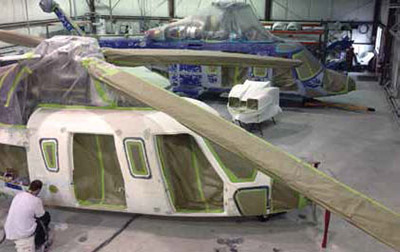

What qualifies you to speak on helicopter painting practices?
SureFlight, located about 30 miles west of Philadelphia International Airport, provides full custom new paint jobs for fixed-wing and rotor aircraft as well as small repair painting, changing of accent stripe colors, or changing of N-numbers. The company also provides interior services. Customers include other regional repair stations, regional aircraft suppliers and OEMs as well as direct owner/operators.
As SureFlight’s general manager, I lead a team of top-notch technicians in providing exquisite aircraft exterior and interior finishes. I’ve been painting aircraft for 40 years, and have devoted my career to aircraft refinishing.
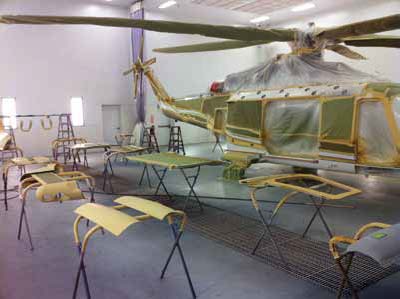
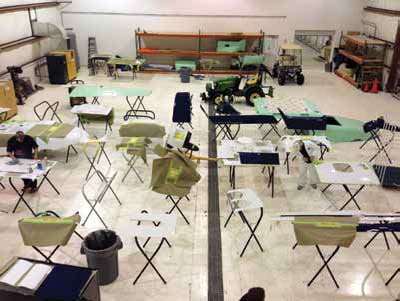
What are the major differences between fixed-wing aircraft and helicopters that affect the painting process?
Helicopters have a variety of uses. Their roles include executive/VIP transport, medical support, offshore support, fire fighting and law enforcement. They also can undertake paramilitary and military roles. As a result, helicopters often have specialized add ons to the exterior body. Fixed-wing aircraft, on the other hand, have very few components that require actual removal during preparation and painting. Helicopters demand expertise in removal and replacement of these parts, each of which requires specific care.
In addition, when you enter a fixed-wing aircraft, many passengers just walk up an airstair and go right in without paying too much attention to the skin. With a helicopter, you can walk up to it at any angle, at any level. The helicopter has to be perfect through 360 degrees. You are touching the helicopter and can see everything as you enter, so attention to detail in the painting process must be extremely high.
On fixed-wing aircraft, the best technician in a crew typically paints at and around the entranceway. That approach does not work for helicopters, where all surfaces are close by and in view.
Describe the ideal process for painting a helicopter.
Helicopter painting is an intensive, detailed process. In our shop, every exterior part comes off of the helicopter during preparation — every cowling, every access panel — and is individually addressed. We basically take that helicopter apart, do all of the preparation work and paint the removed parts individually using the base color. Then we reinstall the parts to perform all of the layout work, making sure that everything lines up correctly.
It all starts with preparation. The biggest thing is to prep properly. That includes removing old coatings down to the base and working from scratch to build everything back up.
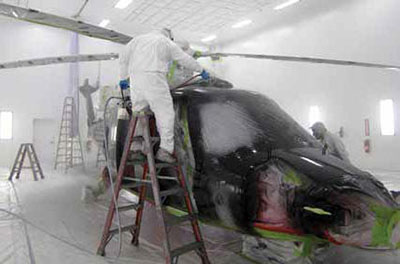
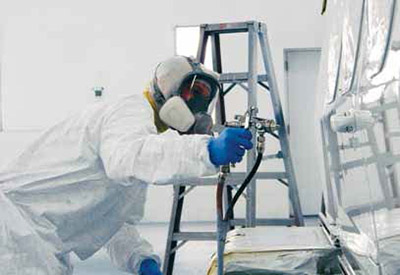
Should we worry about various skin materials when performing preparation and painting?
Yes! Helicopter surfaces may include aluminum, aluminum composites, carbon fibers, Kevlar, etc. It is crucial to identify the materials to be worked on. Treating composites or Kevlar with a chemical stripper can cause major, expensive problems.
How does heat affect the helicopter preparation and painting process?
With helicopters, heat damage can occur at any point past the exhaust cowlings. Almost instantly, exhaust is pushed right back down onto the airframes, especially the tail booms, by the main rotorblade wash. Tail booms take incredible amounts of beating from the heat. Of course, with turbine engines, soot is another major concern. With a fuel-oil mixture funneling through the turbine and exhaust, the incredibly hot, burnt oil dumps right down on top of the tail. Heat like that can bake the resins right out of composites, so keep an eye on those materials.
Depending on the material composition of the helicopter skin, old coatings can be chemically stripped, then the material can be checked for corrosion and other damage. When encountering composite material, we sand it and then look for cracks and stress.
What effect does cleaning have on a helicopter coating?
Cleaning brings positives and negatives. With all of the soot and other material that can build on the skin during takeoff, flight and landing, a helicopter’s exterior must be cleaned after each use. That can wear a coating. You want a good paint product that doesn’t mind getting cleaned every day — something very durable.
How can clearcoats combat the negative effects of cleaning?
I like using clearcoats because of the durability and the depth of image they provide. The helicopter surface is being washed and polished all the time, so with a good clearcoat, you are not affecting the topcoat’s pigmentation — you are just cleaning and polishing your clear.
When we spray our colors, we usually put a coated clear on a color right away as a wet-on-wet process. Then we go back to sand it and add two more coats of clear. When a helicopter leaves our shop, it has three coats of clear. That gives longevity to the paint job for helicopters that have to deal with heat, dirt, cleaning and polishing every day.
How does weight factor into the painting process?
I’m seeing customers place more and more equipment into and onto their helicopters to keep pace with how their fixed-wing aircraft are outfitted. Of course, that adds weight. With that in mind, it helps to be conscious of weight when applying filler — use only as much as you need. The basecoat can consist of a crosscoat or two, and with the addition of color you are just looking for uniformity. Let your gloss and depth come out via the clearcoat. Clearcoats are lighter than basecoat colors, and provide the finish and durability, so don’t skimp there.
Overall, the entire paint job for a helicopter may only consist of 10 gallons, and a portion of that is lost to the atmosphere during spray application. So painting ultimately adds little weight to the aircraft.
How important is training in helicopter painting?
In my shop, we have 12 technicians and every one of them is trained each year by the coatings manufacturers. With the need to remove and replace components, identify the various materials and ensure that the entire helicopter surface is pristine, training to develop and maintain a skilled crew is all important.
Are the current coating offerings sufficient?
I’ve been painting aircraft since I was 16 years old, and as long as you follow manufacturers’ guidelines and use the right equipment, the coatings are the best they have ever been. As opposed to the automotive industry, which uses water-based paint but still employs solid-based clearcoats to obtain the desired finishes, aviation has figured out a better way.
We use aerospace coatings from several manufacturers, but recently painted an extremely detailed Agusta Westland AW139. We applied six different colors and then clearcoat, and used a mix of Sherwin-Williams SKYscapes polyester urethane basecoat and its Acry Glo acyclic urethane to apply everything in the color scheme.
In general for aviation painting, the pigments and resins are solid based as are the clearcoats, but are within all required VOC limits throughout the United States. The aircraft-finishing industry is on top of things nowadays.
Depending on the quality of the work and the level of after-job care, a helicopter paint job can last from four to 10 years.
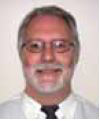 As general manager, DeWitte Binkley leads SureFlight’s team of highly-trained technicians to provide exquisite aircraft exterior and interior finishes. Located in Coatesville, PA, Binkley was SureFlight’s first employee and a foundational part of its management team. Prior to joining SureFlight, he served for 22 years as a supervisor at Sikorsky’s Keystone Helicopter. Prior to Keystone, he managed Agusta Westland’s paint shop. Binkley’s career started with Atlantic Aviation in Wilmington, DE, and he has been devoted to aircraft refinishing.
As general manager, DeWitte Binkley leads SureFlight’s team of highly-trained technicians to provide exquisite aircraft exterior and interior finishes. Located in Coatesville, PA, Binkley was SureFlight’s first employee and a foundational part of its management team. Prior to joining SureFlight, he served for 22 years as a supervisor at Sikorsky’s Keystone Helicopter. Prior to Keystone, he managed Agusta Westland’s paint shop. Binkley’s career started with Atlantic Aviation in Wilmington, DE, and he has been devoted to aircraft refinishing.
